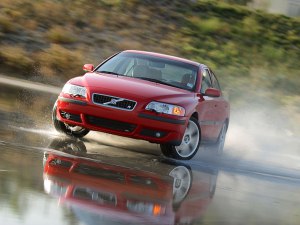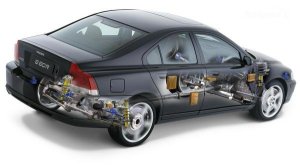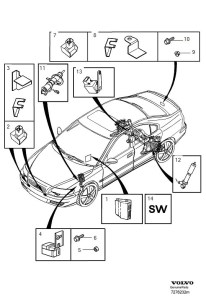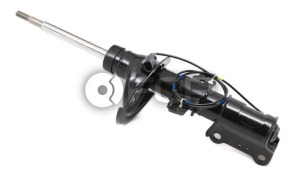For the 2004 model year lineup Volvo needed something unique for their suspension systems when they launched their new performance flagships, the S and V70R. The cars came with 300 brake horsepower, a phenomenal Brembo braking sys tem utilizing 4-piston calipers at all four corners, fancy body styling and more. But hey, that's what everyone else was doing too. They needed something to set them apart, something a bit less "common." What they needed was a Continuously Controlled Chassis Concept. The Four-C suspension was born.
tem utilizing 4-piston calipers at all four corners, fancy body styling and more. But hey, that's what everyone else was doing too. They needed something to set them apart, something a bit less "common." What they needed was a Continuously Controlled Chassis Concept. The Four-C suspension was born.
Ahead of its time
At the time of its debut there were only 4 other vehicles utilizing a similar system. The Chevrolet Corvette used a Delphi system, the BMW 7-Series Sachs CDC+ARC+level control, The Lancia Thesis used the Sachs system, and the Ferrari 360 Modena which also went with the Sachs. Wh ile every other car manufacturer was still stuffing "sport shocks" into their cars, Volvo decided to go with something a bit more sophisticated.
ile every other car manufacturer was still stuffing "sport shocks" into their cars, Volvo decided to go with something a bit more sophisticated.
The Four-C system has 3 positions - Comfort, Sport, and Advanced which can be selected by the touch of a button on what Volvo calls the "ASC" switch, located on the instrument panel. The Four-C system works in conjunction with its Haldex AWD system and Dynamic Stability and Traction Control System (DSTC) to provide more power to the rear wheels when accelerating and cornering while giving more power to the front when driving straight to maintain directional stability. It's also used to stiffen up the shocks when braking to prevent diving and to achieve the best possible braking performance.
4C is more than just smart struts
When a particular mode is selected the system responds to the new desired mode within a few milliseconds. Comfort mode provides a higher level of comfort while the sport setting is much more firmly damped. The Advanced setting is where the fun begins, dampening the struts extremely firm and considered by some to be a bit, well, harsh. The system consists of two control sub-systems which are BODY and CHASSIS. The body system controls Dynamic Cornering Control, Dive and Lift Control, and Dynamic Body Control while the Chassis system controls brake grip control, bump and rebound control, wheel hop control, and advanced sport control. 4C's central control module is called the SUM, which stands for "Suspension Module." The SUM receives inputs from:

- Steering Angle Sensor (SAS)
- Brake Control Module (BCM)
- Drivers Information Module (DIM)
- Central Electronic Module (CEM)
- An accelerometer located in the front of the vehicle
- An accelerometer located in the rear of the vehicle
- Engine Control Module (ECM)
- Transmission Control Module (TCM)
- DSTC sensor module
- Level control sensor
- Shock absorbers at all four wheels
The SUM is a module located on the high speed network which uses CAN to communicate with other modules and can be reprogrammed via a download when software updates are available. The SUM was developed by Volvo and manufactured by Motorola. It's responsible for controlling the shock absorber valves calculated at 500 times per second while the body movement and adaptations are calculated 100 times per second! It's also responsible for calculating the car's current and upcoming movements based off of inputs from the system's sensors which are used to make the ride as comfortable as possible. The shock absorbers were developed by Monroe and use an adjustable electronic valve internally that is activated by the current in a surrounding solenoid. The control valve is variable and is constantly being monitored by the SUM which uses pulse width modulation to control the current to it. Basically, low currents from the SUM to the valve will give low damping forces, while a high current will provide high damping forces. The SUM will look at things such as:
 Acceleration via Throttle
Acceleration via Throttle- Engine Torque
- Degree of braking
- The steering wheel position
- The position of each wheel
- Acceleration of the vehicle
Volvo also uses a similar 4C system in their P2 chassis S80 as well as several of their current model P3 chassis vehicles which still prove to be a great, albeit expensive feature to any model when considering your suspension options.











